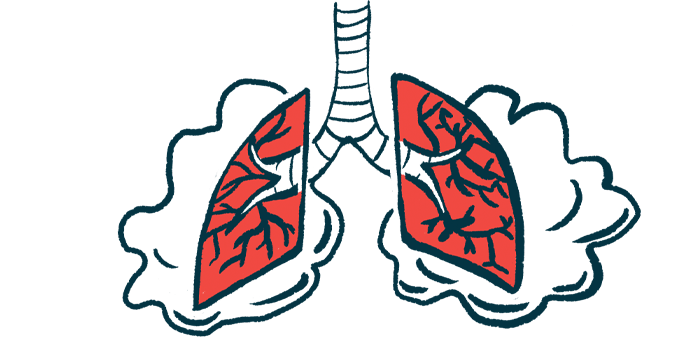Pulmonary Hypertension in SSc Patients Found to Shorten Survival

Having pulmonary hypertension shortens survival in people with scleroderma, also called systemic sclerosis (SSc), according to a Brazilian study that followed patients for up to three years and used a computer algorithm to analyze the results.
Specifically, this lower survival rate in SSc patients with pulmonary hypertension was particularly associated with a diagnosis of borderline pulmonary arterial hypertension (PAH) or interstitial lung disease (ILD) — a group of lung disorders in which the tissue in and around the lung air sacs becomes inflamed and scarred.
“Patients with SSc-PH and [borderline]-PAH had significantly higher mortality than patients with no PH,” the researchers wrote. “Thus, PH is a major cause and condition related to death in SSc patients.”
The study, “Pulmonary hypertension in systemic sclerosis: diagnosis by systematic screening and prognosis after three years follow-up,” was published in the journal BMC Pulmonary Medicine.
Scleroderma can lead to fibrosis (scarring) and damage to blood vessels in multiple organs, including the lungs. In some patients, these changes can cause PAH, a disease marked by high blood pressure in blood vessels that transport blood through the lungs.
Pulmonary hypertension (PH) is a leading cause of mortality in scleroderma. Over the last decade, computer algorithms — such the DETECT algorithm — have been proposed as an effective approach for the early detection of SSc-PAH.
The DETECT algorithm performs its analysis in two steps. First, it analyzes six clinical variables to determine whether a patient needs an echocardiogram, which provides images of the heart. Then, it incorporates that result to assess whether that patient should be referred for right heart catheterization or RHC — considered the “gold standard” for PAH diagnosis.
In this study, researchers at the State University of Rio de Janeiro, in Brazil, evaluated the performance of the DETECT algorithm in combination with the 2009 European Society of Cardiology and the European Respiratory Society (ESC/ERS) Guidelines in the early detection of SSc associated with pulmonary hypertension. This was used as a systematic screening.
Patients were referred to RHC if they fulfilled pre-defined criteria based on the ESC/ERS 2009 guidelines, which included shortness of breath. They also were referred, if negative for this initial step, based on the presence of telangiectasias — small blood vessels that become dilated near the surface of the skin— and anti-centromere autoantibodies, which are characteristic self-reactive antibodies in scleroderma, among other criteria.
The study included 65 patients with a mean age of 50.5, who were screened from July 2014 to June 2017. Of them, 56 were women and nine men, and 25 had limited cutaneous SSc; the other 40 had the diffuse cutaneous form.
A total of 19 patients were immediately referred to RHC, after showing a tricuspid regurgitation velocity (TRV) above 2.9 meters per second (m/s). The TRV measures the speed at which blood leaks between the two chambers that comprise the right side of the heart.
An additional patient had a TRV of 2.4 m/s but was referred to RHC based on the DETECT criteria.
The remaining 45 patients were considered to have a low risk of PAH and were not referred to RHC.
Among the 20 referred patients, 11 (55%) were diagnosed with SSc-PAH, two (10%) were classified with PH group 2, and the other two (10%) were identified as PH group 3. This group includes patients with PH due to lung disease. Five patients did not have pulmonary hypertension.
Notably, of the 11 found to have SSc-PAH, five were considered to have borderline PAH; their mean pulmonary artery pressure, or mPAP, was above 20 but under 25 mmHg.
Patients with SSc-PAH had a higher frequency of lcSSc diagnosis. The frequency of telangiectasia and levels of uric acid were significantly higher than in participants without pulmonary hypertension. In addition, their diffusion capacity for carbon monoxide — a standard measure of the lungs’ capacity to transfer oxygen to blood cells — was lower compared with people with scleroderma but not pulmonary hypertension.
The 65 patients were followed for a mean of 31.5 months (two years and seven months) after providing informed consent or from the date of the RHC.
Overall, people with SSc-PH had significantly shorter survival rates than those without PH. For example, the survival rate at three years was 92% among patients without pulmonary hypertension, but dropped to 53.3% in those with this complication.
Borderline PAH had a worse survival when compared with people with SSc and pulmonary hypertension who received treatment.
Participants with an mPAP of 25 mmHg or above received a specific PAH therapy, combo therapy, or treatment changes as needed. This subset of patients had a survival rate of 75% by year.
Among those with borderline PAH, who did not receive any PAH-specific treatment, three patients died, one developed rapidly progressive SSc-PAH, and the other remained stable.
Overall, the study shows that while TTE (transthoracic echocardiography) “could identify all patients with mPAP [at or above] 25 mmHg,” the researchers wrote, “more sensitive criteria were necessary to detect mPAP [under] 20 mmHg.”
“Mortality remains high in SSc-PH but was more related to [borderline]-PAH and SSc-ILD-PH, while in SSc-PAH, the prognosis was better,” they added.
Among the study limitations, according to the team, were that not all participants completed the study and that RHC was not performed for all patients.








